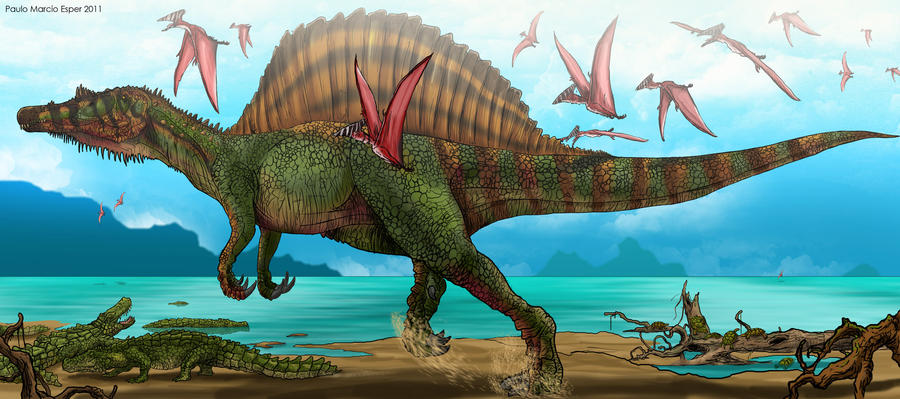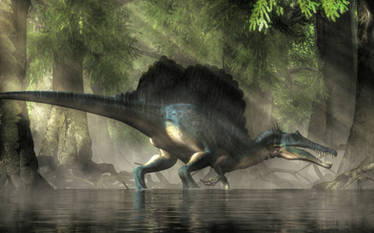ShopDreamUp AI ArtDreamUp
Deviation Actions
Description
O Oxalaia quilombensis é uma nova espécie de espinossaurídeo encontrada por paleontólogos durante uma expedição na Ilha de Cajual, no Maranhão. Ele foi o maior dinossauro carnívoro que viveu no litoral brasileiro e foi nomeado pelos paleontólogos Alexander W.A. Kellner, A.K. Sergio Azevedo, Elaine Machado, Luciana B. Carvalho e Deise D.R. Henriques em 2011.
A espécie é muito semelhante a outras já descritas na África. Isso pode ser explicado se pensarmos que, no período histórico anterior, aquele continente era ligado à América do Sul, o que proporcionou a migração de animais de uma região para outra.
Os espinossaurídeos – família a qual pertence o Oxalaia – eram terópodos e se destacavam por possuírem focinhos longos e estreitos, armados com dentes afiados e uma grande garra nas patas dianteiras. Estas adaptações indicam que esses animais podiam ter grande aptidão para “fisgar” peixes. No entanto, é pouco provável que a dieta dos espinossaurídeos tenha sido exclusivamente de peixes. A presença de dentes destes animais cravados em esqueletos de outros seres fossilizados indicam que eles poderiam se alimentar de animais terrestres também. Além disso, o espinossaurídeos eram tão grandes quanto o Tiranossauro Rex e não sobreviveriam comendo apenas animais tão pequenos quanto peixes.
...............................................................................................
English
The Oxalaia quilombensis is a new kind of espinosaurid by paleontologists found during an expedition on the island of Cajual in Maranhão. It was the largest carnivorous dinosaur that lived on the Brazilian coast and was named by paleontologists Alexander WA Kellner, AK Sergio Azevedo, Elaine Machado, Luciana B. Deise R. Carvalho and D. Henriques in 2011.
The species is very similar to others already described in Africa. This can be explained if we think that in the earlier period of history, the continent was linked to South America, which led to the migration of animals from one region to another.
The espinosaurids - the family that owns the Oxalaia - and theropods were noted for having long, narrow snouts, armed with sharp teeth and a large claw on the front paws. These adaptations indicate that these animals could have great ability to "catch" fish. However, it is unlikely that the diet has been espinossaurídeos exclusively of fish. The presence of teeth of animals carved in fossilized skeletons of other beings indicate that they could feed on terrestrial animals as well. In addition, the espinossaurídeos were as big as Tyrannosaurus Rex and not survive eating only animals as small as fish.
A espécie é muito semelhante a outras já descritas na África. Isso pode ser explicado se pensarmos que, no período histórico anterior, aquele continente era ligado à América do Sul, o que proporcionou a migração de animais de uma região para outra.
Os espinossaurídeos – família a qual pertence o Oxalaia – eram terópodos e se destacavam por possuírem focinhos longos e estreitos, armados com dentes afiados e uma grande garra nas patas dianteiras. Estas adaptações indicam que esses animais podiam ter grande aptidão para “fisgar” peixes. No entanto, é pouco provável que a dieta dos espinossaurídeos tenha sido exclusivamente de peixes. A presença de dentes destes animais cravados em esqueletos de outros seres fossilizados indicam que eles poderiam se alimentar de animais terrestres também. Além disso, o espinossaurídeos eram tão grandes quanto o Tiranossauro Rex e não sobreviveriam comendo apenas animais tão pequenos quanto peixes.
...............................................................................................
English
The Oxalaia quilombensis is a new kind of espinosaurid by paleontologists found during an expedition on the island of Cajual in Maranhão. It was the largest carnivorous dinosaur that lived on the Brazilian coast and was named by paleontologists Alexander WA Kellner, AK Sergio Azevedo, Elaine Machado, Luciana B. Deise R. Carvalho and D. Henriques in 2011.
The species is very similar to others already described in Africa. This can be explained if we think that in the earlier period of history, the continent was linked to South America, which led to the migration of animals from one region to another.
The espinosaurids - the family that owns the Oxalaia - and theropods were noted for having long, narrow snouts, armed with sharp teeth and a large claw on the front paws. These adaptations indicate that these animals could have great ability to "catch" fish. However, it is unlikely that the diet has been espinossaurídeos exclusively of fish. The presence of teeth of animals carved in fossilized skeletons of other beings indicate that they could feed on terrestrial animals as well. In addition, the espinossaurídeos were as big as Tyrannosaurus Rex and not survive eating only animals as small as fish.
Image size
2362x1047px 680.37 KB
© 2011 - 2024 pauloomarcio
Comments28
Join the community to add your comment. Already a deviant? Log In
Nostalgia.....





































